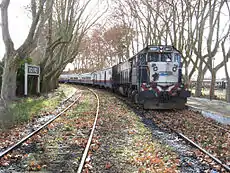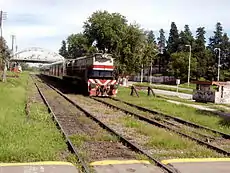Ferrobaires
The Unidad Ejecutora del Plan Ferroviario Provincial (UEPFP) (in English: "Executive Unit of the Provincial Railway Plan"), mostly known for its trade name Ferrobaires, was a public railway company which operated extensive long-distance passenger trains throughout Buenos Aires Province in Argentina. The company was primarily owned and funded by the Buenos Aires provincial government led by Eduardo Duhalde. The name "Ferrobaires" is a combination of the Spanish words for "Rail Buenos Aires."
 | |
 A Ferrobaires train to Junín in 2000 | |
| Ferrobaires | |
| Type | Public |
| Industry | Railway |
| Fate | Defunct [1] |
| Predecessor | Ferrocarriles Argentinos |
| Successor | Trenes Argentinos [1] |
| Founded | 15 January 1993 in La Plata, Argentina[2] |
| Founder | Government of Buenos Aires Province |
| Defunct | January 22, 2018 [3] |
| Headquarters | , |
Area served | Buenos Aires Province |
Key people | Héctor Dotti [4] (General Administrator) |
| Services | Rail transport |
| Owner | Buenos Aires Province |
From its base in the city of Buenos Aires, Ferrobaires rail lines extended to the south and west across the province. The company transported approximately 1.5 million passengers annually and operated from all three major rail termini in the city of Buenos Aires: Retiro (San Martín), Constitución, and Once, running trains on its 5,500-km rail tracks.[6]
History
Background



All of the routes currently managed by Ferrobaires were previously run by Ferrocarriles Argentinos, the country's now-defunct national passenger railway corporation. After the privatisation of Ferrocarriles Argentinos starting in 1992, many train services across Argentina were indefinitely discontinued. In 1992, Gobernor of Buenos Aires Province, Eduardo Duhalde, signed Decree 560/91 by which Buenos Aires requested National Government to transfer the operation of the lines deactivated between 1961 and 1992, that totalized more than 5,500 km of rails. Buenos Aires would work with each Municipal Government with the purpose of creating a company that operated the railway services.
On April 28, 1992, Buenos Aires officially requested the transfer of the 52 lineas and branches in disuse. In January 1993, "Unidad Ejecutora del Programa Ferroviario Provincial" (UEPFP) was created[6] through decree n° 99/93.[2] However, several lines were cancelled or definitely closed by the UEPFP, specially during the 2001 financial crisis.[7]
By National decrees 1168/1992 y 770/1993, the Government of Argentina transferred to the Government of Buenos Aires Province the operation of several lines in Buenos Aires, La Pampa and Río Negro Provinces.
Lines to operate included Constitución to Mar del Plata, Bahía Blanca, Bariloche, Quequén and Bolívar; Olavarría to Bahía Blanca; Once to General Villegas, Toay, General Pico, and Darragueira; Retiro (San Martín) to Alberdi and Junín; and Federico Lacroze to Rojas.
Operation
Ferrobaires reactivated some lines that had been abandoned for many years (such as the Mar del Plata–Miramar or Gral. Guido–Gral. Madariaga, closed in 1978)[8] and even built and opened a new station ("Divisadero de Pinamar", replacing the original station) on the Gral. Guido–Vivoratá branch, in 1996. Trains ran again to Pinamar after 29 years of being inactive.[9]
Nevertheless, those lines would be closed again due to lack of maintenance and rolling stock to supply deteriorated material. The branch to Pinamar was closed in April 2011, remaining inactive up to present days.[10]
In early 2006, the national Ministry of Planning considered taking control of the company to arrange its reprivatization, but the provincial government of Felipe Solá refused to allow this to happen, arguing that under provincial state control the company was working very efficiently and with low fares.
On February 8, 2007, the Provincial Government agreed to transfer all the services to the National Government to keep the lines active[11] so much of them were frequently interrupted due to technical problems. Nevertheless, this never happened and Ferrobaires continued being managed by Buenos Aires.[7][12]
By 2011 Ferrobaires was widely criticized by users and journalists because of its severe operational problems to run the services.[7][13]
In July 2015, Ferrobaires announced the reestablishment of services from Plaza Constitución to Pinamar that had been suspended in 2010.[14] with one service per week,[15] and intermediate stops at Santo Domingo, Segurola, Monsalvo and Invernadas and Gral. Madariaga.[16] Finally on July 17, the service was put into operation again.[17]
Decline
In June 2016, after a train collided with a Belgrano Cargas y Logística freight formation in Rawson, a city in Chacabuco Partido, the Government of Buenos Aires Province led by María Eugenia Vidal ordered the suspension of all services (eight in total) operated by Ferrobaires. That decision was taken alleging "the need of preserving security of passengers and service operators".[18]
Nevertheless, it was announced that the service from Constitución to Mar del Plata would remain active as it would be transferred to the National Government. Likewise, a report by "Auditoría General de la Nación" (General Auditing Office of Argentina) revealed that rolling stock, rail tracks and signal systems were severely deteriorated due to the lack of maintenance. As of June 2016, the operation of services by Ferrobaires costed $ 1,200 million per year, with incomes for only 60 million.[5]
In July 2016, it was announced that Ferrobaires would be shut down and all of its personnel and infrastructure transferred to the National Government,[19] a process that had been unsuccessfully attempted in 2007.[20] Therefore, passenger services formerly operated by the provincial administration (since 1993) would be run by Operadora Ferroviaria Sociedad del Estado (SOFSE).[21] In January 2018, Governor Vidal signed the decree to transfer Ferrobaires services and assets to the National State.[1][3]
Services took over by SOFSE include the following lines: Plaza Constitución to Bahía Blanca, Bariloche, Quequén and Bolívar; Olavarría to Bahía Blanca; Once to Toay, General Pico, General Villegas, Darregueira and Lincoln; Lincoln to Villegas and Pasteur; Retiro to Alberti and Junín; Federico Lacroze to Rojas. All those services were part of the original diagram by the Buenos Aires province in 1992. The Mar del Plata – Miramar and General Guido – General Madariaga lines (not included in the original Decree N° 1168/92)[21] had been reestablished by the Provincial Government after the transfer of the services.[22]
Services
At the moment of its closure (June, 2016), Ferrobaires operated the following services:[23]
| Start | End | Dist./Km | Days of service | Rail line |
|---|---|---|---|---|
| Constitución | Mar del Plata | 400 | Mon-Sun | Roca |
| Tandil | 330 | Tue, Fri | ||
| Bahía Blanca (via Lamadrid) | 680 | Mon, Wed, Fri | ||
| Bahía Blanca (via Pringles) | 640 | Tue, Thu | ||
| 25 de Mayo | 205 | Tue, Fri | ||
| Tandil | Vela | 48 | Wed, Sun | |
| Retiro (San Martín) | Alberdi | 336 | Fri | San Martín |
| Once | Bragado | 209 | Mon-Sat | Sarmiento |
References
- Vidal cerró Ferrobaires y los trenes pasan a Nación, Rieles.com, 22 Jan 2018
- Decreto n° 99/93: CRÉASE LA UNIDAD EJECUTORA DEL PROGRAMA FERROVIARIO PROVINCIAL on Government of Buenos Aires website
- Vidal oficializó el decreto para suprimir Ferrobaires y los trenes pasan a manos de Nación, El Día, 22 Jan 2018
- "Vidal removió al titular de Ferrobaires", Ambito.com, 23 Feb 2016
- "Ferrobaires, una ilusión ferroviaria que perdía millones" by Diego Cabot, La Nación, 30 June 2016
- "Ferrobaires: La idea que no fue" on Portal de Trenes website
- "Una empresa con la marca en el orillo" on Página/12, 18 Feb 2011
- "Entre Madariaga y Pinamar" on Rumbo al Sud, 17 Ago 2010 (Archive)
- "Pinamar ya tiene su ferrocarril", La Nación, 8 Dec 1996
- "Trenes a Pinamar" on Satélite Ferroviario
- Decreto N° 1021/07, 5 June 2007 - Government of Buenos Aires website
- "Sobre la situación en Ferrobaires" by M. Isabel Gainza
- "Ferrobaires: sólo funcionan siete locomotoras de las 70 que la Nación transfirió en 1993", El Día, 4 May 2011
- "Anunciaron el regreso del tren a Pinamar tras 5 años de inactividad", La Noticia 1, 1 Jul 2015
- "Vuelve a circular el tren turístico a Pinamar", Diario Jornada, 1 Jul 2015
- "El tren Caba-Pinamar hará paradas en estaciones intermedias", 0223.com.ar, 17 Jul 2015
- "Volvió el tren que une Constitución con Pinamar", InfoNews, 18 Jul 2015
- "Tras el choque de trenes en Rawson, Ferrobaires suspendió sus servicios", Clarín, 30 June 2016
- Se oficializó traspaso de Ferrobaires a Nación, Infocielo, 26 Jul 2017
- DECRETO n° 1021/07 - Gobierno de la Provincia de Buenos Aires, Jun 5, 2007
- Ministerio de Transporte de la Nación – Resolución 517-E/2017 (Full text) at Official Bulletin of Argentina
- Estación General Madariaga at Museo Ferroviario de Ranchos
- "Destinos" on Ferrobaires website, 16 March 2015
| Wikimedia Commons has media related to Ferrobaires. |